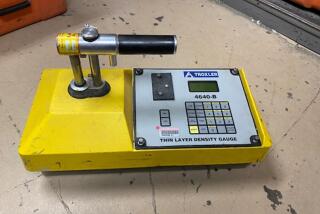Glitches hamper radiation warning system in California
The federal government’s radiation alert network in California is not fully functional, leaving the stretch of coast between Los Angeles and San Francisco without the crucial real-time warning system in the event of a nuclear emergency.
Six of the Environmental Protection Agency’s 12 California sensors — including the three closest to the Diablo Canyon nuclear power plant near San Luis Obispo — are sending data with “anomalies” to the agency’s laboratory in Montgomery, Ala., said Mike Bandrowski, manager of the EPA’s radiation program.
The problem delays from 30 minutes to several hours the updating of a database that would be critical for warning the public in case of a sudden radiation danger from air wafting to the United States from a foreign country, for example, or from a radiation leak at a domestic nuclear facility.
The lag has not been a concern during the Japanese nuclear crisis because the minuscule amounts of radiation that have reached California have posed no threat to human health, and the plume of irradiated air from Japan is so widespread that other equipment from Washington to Los Angeles has been able to monitor it in real time, Bandrowski said.
The agency’s critics, however, say the weakness in the EPA system could pose a public health concern.
“The unreliability of the EPA monitoring effort revealed by this event raises troubling questions about whether Californians would receive timely warning to evacuate, or take other protective actions, in case of a nuclear accident here,” said Dan Hirsch, a nuclear policy lecturer at UC Santa Cruz and president of the Committee to Bridge the Gap, an anti-nuclear group.
The troubled transmissions are part of the federal RadNet system, which is “designed to protect the public by notifying scientists, in near real time, of elevated levels of radiation so they can determine whether protective action is required,” according to a recent press release from the agency.
Without immediate information from RadNet, state and local emergency managers would be dependent on the private owners of nuclear power facilities to alert them in the first hours of a dangerous radiation leak from a domestic source.
“I believe the utilities monitor the sensors; they’re good about reporting things,” said David McIntyre, a spokesman for the Nuclear Regulatory Commission, which oversees nuclear reactors in the U.S. He added that federal regulations require nuclear plant operators to report small problems that could lead to a release of radiation, so it’s unlikely such an event would come as a surprise.
Paul Flake, a spokesman for Pacific Gas & Electric’s Diablo Canyon plant, said late Thursday that he did not have details at hand about the company’s monitoring system and warning protocols.
Tokyo Electric Power Co., which runs the stricken Fukushima nuclear power plant in Japan, was widely criticized for failing to provide timely, accurate data about the pending danger to the Japanese government, which was reliant on the company for such information.
“There’s a natural reluctance to reporting something embarrassing,” said Arjun Makhijani, president of the Institute for Energy and Environmental Research.
The California Department of Public Health maintains two of its own sensors at each of the state’s nuclear power plants — at Diablo Canyon and at San Onofre near San Clemente — but data from those devices are collected every 48 hours, said Jordan Scott, a spokesman with the California Emergency Management Agency. Before the accident in Japan, data was collected once a week, Scott said.
There are other detectors spread across the United States, including some at universities and some deployed by the Department of Homeland Security in large cities when a terrorist threat is received. But none of those transmits data in real time to a dedicated early-warning system, officials said.
The Comprehensive Nuclear-Test-Ban Treaty Organization, based in Vienna, has four real-time radiation monitors in the continental U.S. The one in Sacramento, operated by the U.S. Department of Energy, was the first to detect traces of radiation from Japan in California.
But that system is designed to detect evidence of nuclear bomb tests, not to notify the U.S. public to evacuate or take other precautions if elevated levels of radiation are detected.
At the outset of the Japanese crisis, environmentalists noticed that a map on the Environmental Protection Agency’s website showing the locations of the monitors nationwide indicated that only about half were “running.” Most of the others were producing data that was “undergoing quality review.”
The website has since been updated to say that data from the problematic monitors “is being reviewed at EPA’s National Air and Radiation Environmental Laboratory” and that the sensors are still collecting data.
Bandrowski said the data from those sensors, transmitted via satellite to the Alabama lab every hour, arrive with problems that mean it can’t be added to the database automatically. Instead, a staff member has to manually review the information, a process that can take up to several hours.
“That’s the nature of satellite transmissions,” Bandrowski said. “There’s always going to be glitches.”
More: Articles, videos and graphics on radiation exposure, nuclear crisis
Times staff writer Ken Bensinger also contributed to this story from Los Angeles.
More to Read
Start your day right
Sign up for Essential California for news, features and recommendations from the L.A. Times and beyond in your inbox six days a week.
You may occasionally receive promotional content from the Los Angeles Times.








